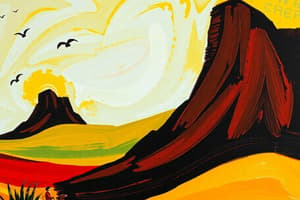Podcast
Questions and Answers
________ deserts form on the leeward (dry) side of mountain ranges.
________ deserts form on the leeward (dry) side of mountain ranges.
- Subtropical
- Rain-shadow (correct)
- Coastal
- Tropical
Deserts do not need to be in hot regions; they only need to be ________, for example, deserts can form in cold, dry, ________ regions.
Deserts do not need to be in hot regions; they only need to be ________, for example, deserts can form in cold, dry, ________ regions.
- humid; subtropical
- arid; polar (correct)
- dry; tropical
- humid; polar
According to the textbook, the highest recorded temperature on Earth was in a ________.
According to the textbook, the highest recorded temperature on Earth was in a ________.
- low-latitude, high-elevation desert in Mexico
- low-latitude, low-elevation desert in Libya (correct)
- high-latitude, high-elevation desert in Mongolia
- tropical rain forest in Brazil
Deserts represent ________ of Earth's surface.
Deserts represent ________ of Earth's surface.
________ deserts occur due to the drying out of air masses over the equatorial rain forests.
________ deserts occur due to the drying out of air masses over the equatorial rain forests.
To qualify as a desert, a region must ________.
To qualify as a desert, a region must ________.
Desert climate associated with a rain-shadow is found ________.
Desert climate associated with a rain-shadow is found ________.
A desert may form along a coastline because a _____
A desert may form along a coastline because a _____
Which desert is the result of air masses that dry out as they cross over land?
Which desert is the result of air masses that dry out as they cross over land?
The figure below illustrates the formation of a ________ desert.
The figure below illustrates the formation of a ________ desert.
The deserts found in the western United States are primarily the result of being located ________.
The deserts found in the western United States are primarily the result of being located ________.
The measured rainfall shown in the figure below is characteristic of a ________ desert.
The measured rainfall shown in the figure below is characteristic of a ________ desert.
Why do deserts form at high elevations?
Why do deserts form at high elevations?
Why do deserts form in polar regions?
Why do deserts form in polar regions?
As shown in the figure below, wind erosion can create a faceted rock known as a ________.
As shown in the figure below, wind erosion can create a faceted rock known as a ________.
________ forms when dust carrying microbes sticks to the outside of a rock and forms an iron oxide-rich covering.
________ forms when dust carrying microbes sticks to the outside of a rock and forms an iron oxide-rich covering.
The majority of erosion in the desert is due to ________.
The majority of erosion in the desert is due to ________.
Fine-grained sediment, such as dust and silt, is transported by wind in ________.
Fine-grained sediment, such as dust and silt, is transported by wind in ________.
Physical weathering produces piles of broken rocks called ________.
Physical weathering produces piles of broken rocks called ________.
Physical weathering is more prevalent in the desert due to the ________.
Physical weathering is more prevalent in the desert due to the ________.
Compared with humid climates, the rates of chemical weathering in deserts are ________.
Compared with humid climates, the rates of chemical weathering in deserts are ________.
The saltation of sand involves ________.
The saltation of sand involves ________.
Desert varnish consists of ________.
Desert varnish consists of ________.
In the figure below, the sand grains are being transported by ________.
In the figure below, the sand grains are being transported by ________.
Which of the following is an example of wind erosion?
Which of the following is an example of wind erosion?
Which of the following images is the result of chemical erosion?
Which of the following images is the result of chemical erosion?
What is the largest particle that can be carried as part of the suspended load during wind erosion?
What is the largest particle that can be carried as part of the suspended load during wind erosion?
Most of the erosion in desert environments is caused by ________.
Most of the erosion in desert environments is caused by ________.
Why is chemical weathering relatively rare in deserts?
Why is chemical weathering relatively rare in deserts?
The process of lowering the surface of the land by wind erosion is known as ________.
The process of lowering the surface of the land by wind erosion is known as ________.
Piles of sand that form simple, wave-like shapes are called ________ dunes.
Piles of sand that form simple, wave-like shapes are called ________ dunes.
An apron-shaped pile of alluvium that forms at the mouth of a canyon is known as a(n) ________.
An apron-shaped pile of alluvium that forms at the mouth of a canyon is known as a(n) ________.
Calcrete (caliche) forms in a desert climate through the dissolution and the reprecipitation of ________ during and after rainstorms.
Calcrete (caliche) forms in a desert climate through the dissolution and the reprecipitation of ________ during and after rainstorms.
Iron-rich, well-oxidized strata will be ________.
Iron-rich, well-oxidized strata will be ________.
Mesas, buttes, and chimneys are all the result of ________.
Mesas, buttes, and chimneys are all the result of ________.
When fine-grained sediment is blown away as shown in the figure below, the coarser sediment left behind is known as ________.
When fine-grained sediment is blown away as shown in the figure below, the coarser sediment left behind is known as ________.
Areas with relatively scarce sand and constantly shifting winds will develop ________ dunes.
Areas with relatively scarce sand and constantly shifting winds will develop ________ dunes.
The image below is of a ________ dune.
The image below is of a ________ dune.
Imagine that you come across a flat, thick layer of rock salt in an outcrop. What can you determine about the sedimentary environment in which it was formed?
Imagine that you come across a flat, thick layer of rock salt in an outcrop. What can you determine about the sedimentary environment in which it was formed?
Which of the following images is the result of sediment deposited at the mouth of a canyon?
Which of the following images is the result of sediment deposited at the mouth of a canyon?
The geometry of sand dunes is NOT strongly influenced by the ________.
The geometry of sand dunes is NOT strongly influenced by the ________.
How do chimneys (also called hoodoos) and yardangs differ?
How do chimneys (also called hoodoos) and yardangs differ?
________ results from the transformation of a once-fertile area to an arid desert.
________ results from the transformation of a once-fertile area to an arid desert.
Which of the following would NOT be a cause of desertification?
Which of the following would NOT be a cause of desertification?
Which of the following human activities can cause desertification?
Which of the following human activities can cause desertification?
Desertification may also be responsible for which of the following far-reaching consequences?
Desertification may also be responsible for which of the following far-reaching consequences?
Conversion of productive land to desert is known as ________.
Conversion of productive land to desert is known as ________.
The Dust Bowl event in 1933 resulted from which natural event?
The Dust Bowl event in 1933 resulted from which natural event?
The desertification of the Sahel region in Africa was the result of ________.
The desertification of the Sahel region in Africa was the result of ________.
Which of the following hazards could lead to desertification?
Which of the following hazards could lead to desertification?
Flashcards are hidden until you start studying
Study Notes
Rain-shadow Deserts
- Rain-shadow deserts develop on the leeward side of mountain ranges due to orographic lift.
Types of Deserts
- Deserts can be classified by temperature; they are not limited to hot areas but can be arid in polar regions as well.
Temperature Records
- The highest recorded temperature on Earth was in the low-latitude, low-elevation desert located in Libya.
Desert Coverage
- Deserts cover approximately 25% of Earth's surface, highlighting their significant presence.
Subtropical Deserts
- Subtropical deserts form when air masses dry out after crossing equatorial rainforests.
Desert Qualification
- To qualify as a desert, an area must be arid with less than 15% vegetation cover.
Climate Characteristics
- The desert climate associated with rain-shadow effects is found on the leeward side of mountain ranges.
Coastal Deserts
- Coastal deserts can form due to cold ocean currents that cool and dry the air.
Gobi Desert
- The Gobi Desert is caused by air masses losing moisture as they traverse dry land.
Characteristics of Western US Deserts
- Western US deserts primarily arise from being situated within rain-shadows.
Erosion in Deserts
- Most desert erosion is due to water, contradicting the notion that wind is the sole factor.
Sediment Transport
- Fine-grained sediment is transported through the process known as suspension.
Physical Weathering
- Physical weathering in deserts occurs due to high heat and lack of moisture, impacting the rock’s ability to retain heat.
Chemical Weathering
- Chemical weathering is rare in deserts as it predominantly involves reactions with water, which is scarce.
Types of Weathering Rates
- Chemical weathering occurs at a much slower rate in deserts compared to humid environments due to low moisture levels.
Sand Transportation
- Saltation refers to the process where grains travel short distances (about 1 meter) through the air, aided by wind.
Desert Varnish
- Desert varnish consists of dust deposits affected by microorganisms and is formed over time.
Wind Erosion
- Wind erosion in deserts leads to the formation of distinct features like ventifacts and yardangs.
Dune Types
- Transverse dunes are characterized by simple, wave-like shapes formed by wind patterns.
Sedimentary Environments
- The presence of a thick layer of rock salt indicates that the sedimentary environment was arid.
Desertification
- Desertification refers to the transformation of previously fertile land into desert, often due to human activities and natural events.
Causes of Desertification
- Key contributors to desertification include overpopulation, overgrazing, and diversion of water resources, while increased rainfall can mitigate it.
Long-term Drought
- The Dust Bowl of 1933 was primarily caused by long-term drought exacerbated by poor agricultural practices.
Sahel Region Desertification
- The desertification in the Sahel region was influenced by the removal of grasses from the soil due to overpopulation and land practices.
Climate Change Impacts
- Climate change poses a significant risk for increased desertification globally.
Studying That Suits You
Use AI to generate personalized quizzes and flashcards to suit your learning preferences.




